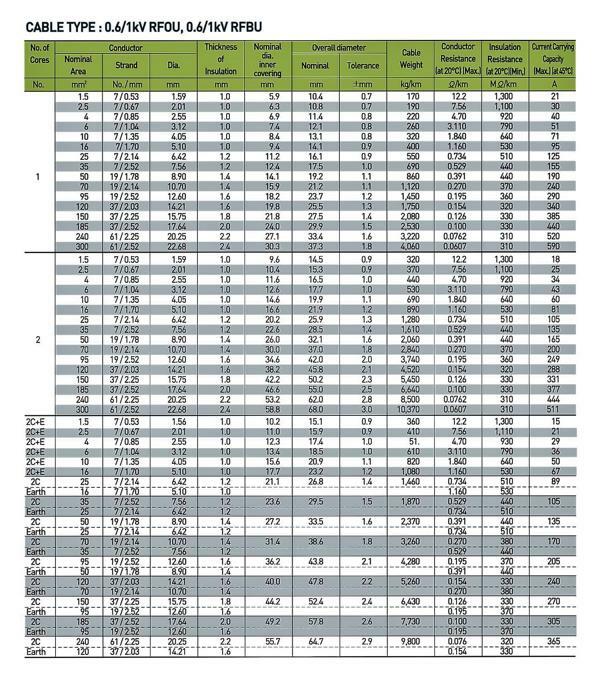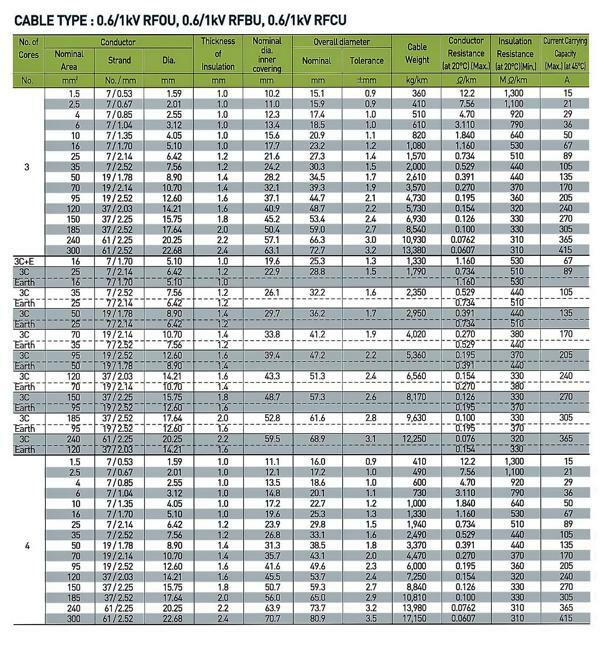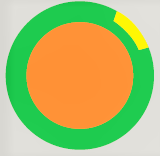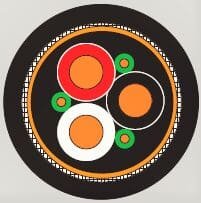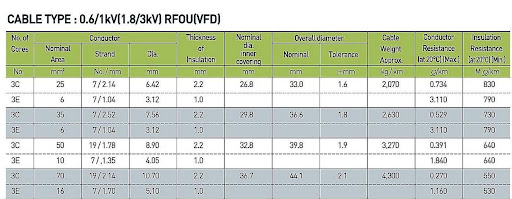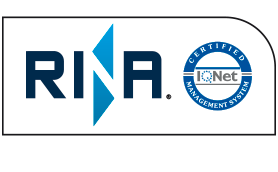Naval Cables – NEK-606/IEC – SHF2 Resistance
Power, control and lighting cables – Flame resistant – SHF2 resistance
INNOVCABLE Power, Control and lighting 0.6/1(1.2)kV RFOU, RFBU, RFCU, TFOU, TFBU, TFCU – P1 and P1/P8 – SHF2 Resistance
1) Conductor formed by tinned electrolytic copper wires, soft temper, class 5 stranding, in accordance with IEC 60228. *1
2) Insulation of conductors in special halogen-free compound LSOH – (Code R(HEPR/EPR), T (XLPE)) – according to IEC 60092-351.
3) Insulated conductors cabled together, non-hygroscopic and flame retardant filaments can be used in the construction of the conductor and tapes can be applied to the conductors.
4) Inner cover in halogen-free polyolefin compound LSOH – (Code F)
5) Frame: *2
– Mesh of tinned copper wires (Code 0)
– Mesh of bronze wires (Code B)
– Mesh of galvanized steel wires (Code C)
6) Final cover in halogen-free polyolefin compound LSOH (SHF2), black. (U Code)
Identification
A-) Number of conductors (Without Earth conductor G)
1C: Single conductor – Black or White
2C: Two conductors – White, Black
3C: Three conductors – White, Black, Red
4C: Four conductors – White, Black, Red and Blue
5C or more: Five conductors or more – Sequentially numbered black or white conductors.
B-) Number of conductors (With Earth conductor G)
2C +E: Three conductors – White, Black, Green
3C +E: Four conductors – White, Black, Red and Green
4C +E: Five conductors -White, Black, Red , Blue and Green
6C or more: Six conductors or more – Black or white conductors numbered sequentially + green track
Nek606 SHF2 cables
Engraving on the outer cover (example): “ano” Innovcable 01 RFOU 0.6/1KV P1/P8 3 x 35/16 mm2 IEC 60332-3-22
Applicable Specifications
Applications
Naval cables for fixed facilities for power, control and lighting in ex environments (zone 0, 1 and 2) and safe areas (SHF2). Nek606 SHF2 cables
Maximum Conductor Temperature
90°C
Notes
Nek606 SHF2 cables
1) The tinned copper conductor can be manufactured in class 2.
2) Separating tape can be applied before/after the frame.
3) Operating voltage: 0.6/1(1.2)kV
**Innovcable reserves the right to change this catalog without prior notice.**
INNOVCABLE Power, Control and Lighting 0.6/1(1.2)kV RU, TU – P18 – SHF2 Resistance
1) Conductor formed by tinned electrolytic copper wires, soft temper, class 5 stranding, in accordance with IEC 60228. *1
2) Insulation of conductors in special halogen-free compound LSOH – (Code R(HEPR/EPR), T (XLPE)) – according to IEC 60092-351.
3) Insulated conductors cabled together, non-hygroscopic and flame retardant filaments can be used in the construction of the conductor and tapes can be applied to the conductors.
4) Final cover in halogen-free polyolefin compound LSOH (SHF2), black. (U Code)
Identification
A-) Number of conductors (Without Earth conductor G)
1C: Single conductor – Black or White
2C: Two conductors – White, Black
3C: Three conductors – White, Black, Red
4C: Four conductors – White, Black, Red and Blue
5C or more: Five conductors or more – Sequentially numbered black or white conductors.
B-) Number of conductors (With Earth conductor G)
2C +E: Three conductors – White, Black, Green
3C +E: Four conductors – White, Black, Red and Green
4C +E: Five conductors -White, Black, Red , Blue and Green
6C or more: Six conductors or more – Black or white conductors numbered sequentially + green track
Nek606 SHF2 cables
Engraving on the outer cover (example): “ano” Innovcable 01 RU 0.6/1KV P18 3 x 2.5 mm2 IEC 60332-3-22
Applicable Specifications
Applications
Naval cables for fixed facilities for power, control and lighting in ex environments (zone 0, 1 and 2) and safe areas (SHF2). Cables have double layer, the simple cables are used as battery cables. Nek606 SHF2 cables
Maximum Conductor Temperature
90°C
Notes
Nek606 SHF2 cables
1) The tinned copper Conductor can be manufactured in class 2.
2) Operating voltage: 0.6/1(1.2)kV
**Innovcable reserves the right to change this catalog without prior notice.**
INNOVCABLE Power 0.6/1kV UX, RX, TX – P15 – SHF2 Resistance
1) Conductor formed by tinned electrolytic copper wires, soft temper, class 5 stranding, in accordance with IEC 60228. *1
2) Insulation of conductors in special halogen-free compound LSOH
– Code R – HEPR/EPR – in accordance with IEC 60092 -351.
– Code T – XLPE – according to IEC 60092-351.
– Code U – SHF2 – according to IEC 60092-359.
3-) Green outer cover.
Identification
Example: “Year” Innovcable UX 1000V P15 1x 95 mm² IEC 332-3-22. Nek606 SHF2 cables
Applicable Specifications
Applications
Insulated conductor for earthing services. According to NEK TS 606: 2009.
Maximum Conductor Temperature
90°C
Notes
Nek606 SHF2 cables
1) The tinned copper conductor can be manufactured in class 2.
2) Polyester tape can be used on the conductor.
3) Operating voltage: 0.6/1kV
**Innovcable reserves the right to change this catalog without prior notice.**
INNOVCABLE Frequency Inverter – 0.6/1kV(1.8/3kV) RFOU(VFD), TFOU(VFD) – SHF2 Resistance
1) Conductor formed by tinned electrolytic copper wires, soft temper, class 5 stranding, in accordance with IEC 60228. *1
2) Insulation of conductors in special halogen-free compound LSOH – (Code R(HEPR/EPR), T (XLPE)) – according to IEC 60092-351.
3) Insulated conductors cabled together, non-hygroscopic and flame retardant filaments can be used in the construction of the conductor and tapes can be applied to the conductors.
4) Inner cover in halogen-free polyolefin compound LSOH – (Code F)
5) Application of copper tape.
6) Frame: *2
– Mesh of tinned copper wires (Code 0)
– Mesh of bronze wires (Code B)
– Mesh of galvanized steel wires (Code C)
7) Final cover in halogen-free polyolefin compound LSOH ( SHF2), in black. (U Code)
Identification
Conductor colors: Black, White, Red
Ground conductor colors: green.
EXTERNAL RECORDING: INNOVCABLE 01 RFOU – VFD 0.6/1(1.8/3)kV 3X95 + 3×16 mm² IEC 60332-3-22
Applicable Specifications
Applications
Special cable for motors and frequency / azimuth engines up to 1 kV. Suitable for voltage peaks up to 3600V. Armored cable for fixed installations on ships and offshore units. It can be installed and operated on both interiors and outdoors. Nek606 SHF2 cables
Maximum Conductor Temperature
90°C
Notes
Nek606 SHF2 cables
1) The tinned copper conductor can be manufactured in class 2.
2) SEPARATORY TABLE BE BEFORE/After the frame may be applied.
3) Operation voltage: 0.6/1kV (1.8/3kV)
** The reserve innovcable the right to change this catalog without any notice. ** Cables Nek606 SHF2
Research and Knowledge Centers
InnovCable: cutting -edge engineering for the challenges of tomorrow
For engineers, researchers and students who are not content with the standard, InnovCable is positioned not only as a cable manufacturer, but as a technological partner at the forefront of innovation . We understand that in sectors such as naval and oil and gas, a cable is not just a component; It is a vital line, the backbone of complex operations that occur in the most severe environments on the planet.
This is why our commitment to cutting -edge research is the core of everything we do.
How InnovCable stands out and innovates:
- Strategic collaboration with the Academy and Institutes: We do not expect the future, we build it together. Innovcable maintains active partnerships with late universities such as USP, Unicamp and Unifei , and constantly dialogues with the challenges presented by centers such as Cenpes and Cepel . We finance master and doctoral projects focused on solving real problems, such as the development of new insulating materials resistant to H₂S gas degradation or modeling of umbilical cable behavior under extreme fatigue.
- Advanced Materials Engineering: Our laboratories go beyond compliance tests. We actively researched and developed high performance elastomeric compounds, capable of supporting abyssal pressure, saline corrosion and temperatures ranging from Arctic to Equatorial. We are pioneers in the application of LSZH compounds (Low Smoke Zero Halogen) Mud-Resistant cable lines are designed to resist the chemical attack of drilling fluids, ensuring circuit integrity for decades.
- Digitization and Industry 4.0 in cables: We see each cable as a smart asset. Innovcable is at the forefront of integration of fiber optic sensors (DSS/DAS) in power and umbilical cables. This allows real -time monitoring of structural integrity, temperature and vibration throughout its extent. For an operations engineer, this means the transition from corrective maintenance to predictive maintenance , avoiding catastrophic failures and optimizing production. We created digital twins of our solutions, allowing accurate simulations that accelerate commissioning and increase project reliability.
- Overcoming standards through innovation: For InnovCable, certifications from entities such as DNV, ABS and Bureau Veritas are not the ultimate goal, but the starting point. Our R&D team analyzes the most strict requirements and develops solutions that outweigh them, offering safety and reliability margins that give our customers peace of mind. When a new challenge arises, such as electrifying platforms to reduce emissions, our engineering team is already working with technical committees to develop high power cables that will make this vision a safe and efficient reality.
For professionals and future engineers seeking to leave their brand, InnovCable offers more than one product: we offer an invitation to solve industry's most difficult problems by connecting the future of energy and navigation with intelligence, safety and a tireless spirit of innovation.
Innovcable Knowledge Bases
- Knowledge Academy: Application and Installation of Moveable Cables - Rolante Bridge, Currency, Festoons, Elevators, Crane Treadmills…
- InnovCable Furniture Guide: What mobile cables do you use?
- Why use InnovCable Mobile Cables: Considerations of why utilize mobile cables
- Cable storage and transportation guidelines
- GLOSSARY: Technical Terms in English
- Color Code Tables: According to DIM47100, BS4737, BS5308
- Copper Temperature Coefficients: Constant to convert resistance at various temperatures to the standard 20 ° CE reference temperature of constants to convert resistance to 20 ° C other temperatures.
- MISCELLANEOUS METAL DATA
- Tables: Cenelec - VDE
- Dimensioning tables: power cables - NBR 5410
- COMPENSATION AND EXTENSION THERMOCOUPLE CABLES AND WIRE TABLES
- Driver Class : mm² x AWG
- Diverse technical information
- Naval cable codes and nomenclatures as per Nek606
- SHF1 AND SHF2 COVERS ACCORDING TO NEK-606
- Resistance of insulation and cover materials, comparative of properties
- Resistance from Armação / Armor Resistance
- Current classifications and voltage drop vol 1 - IEE
- Current classifications and voltage drop Vol 2 - IEE
- Fire Performance Standards: Fire Performance Cable Standards
- Radius of minimum allowed curvature: according to DIN VDE 0298 PART 3
- STANDARDS
- Voltage Fall Calculations: VoltaGe Drop Calculations
Knowledge Bases and Core Topics
This section covers the theoretical and practical pillars of marine and oil & gas engineering.
- HYDROSTATICS AND STABILITY: Principles of buoyancy, intact and damaged stability criteria (SOLAS, IMO).
- HYDRODYNAMICS AND OFFSHORE ENGINEERING: Resistance to progress, propulsion, maneuverability, behavior at sea ( seakeeping ), and analysis of anchoring systems and dynamic positioning.
- NAVAL AND OFFSHORE STRUCTURES: Structural analysis of hulls and platforms (fixed and floating). Fatigue, vibration and response to environmental loads.
- NAVAL AND SUBSEA MACHINES AND SYSTEMS: Propulsion systems, power generation, subsea production systems, umbilicals and risers .
- O&G DESIGN AND TECHNOLOGY: Exploration, drilling and production technologies in deep and ultra-deep waters.
- SAFETY AND REGULATION: Study of international conventions (SOLAS, MARPOL) and the rules of classification societies and regulatory bodies (ANP, DPC).
- MATERIALS AND CORROSION: Naval steels, special alloys, composite materials and corrosion protection technologies in marine environments.
Databases and academic search mechanisms
Essential for researching scientific articles, theses and dissertations.
- IEEE Xplore Digital Library: IEEE
- ACM Digital Library: ACM
- ScienceDirect: SCIENCE DIRECT
- Scopus: SCOPUS
- CAPES Journal Portal: CAPES
- Google Scholar: GOOGLE SCHOLAR
Prominent journals and journals
- Ocean Engineering (Elsevier)
- Journal of Ship Research (SNAME)
- Journal of Petroleum Science and Engineering (Elsevier)
- Journal of Marine Science and Engineering (MDPI)
- Journal of the Brazilian Society of Naval Engineering (SOBENA)
Classification and Certification Societies
Entities that create rules and certify that ships, platforms and equipment are designed, built and maintained safely.
- DNV (Det Norske Veritas): DNV – A world leader and undisputed benchmark in the energy and maritime sectors. Its standards for offshore systems are a global standard.
- ABS (American Bureau of Shipping): ABS – A highly prestigious classification body, with a strong presence in O&G projects and a pioneer in rules for new technologies.
- Lloyd's Register (LR): LR – One of the oldest and most respected, with extensive experience in compliance verification and risk analysis for the energy chain.
- Bureau Veritas (BV): Bureau Veritas – A world leader in testing, inspection and certification (TIC), with a robust marine and offshore division.
- RINA (Registro Italiano Navale): RINA – Founded in 1861, it is a global reference in certification and engineering consultancy for the naval and energy sectors.
- ClassNK (Nippon Kaiji Kyokai): ClassNK – Japan’s main classifying agency and one of the largest in the world.
- IACS (International Association of Classification Societies): IACS – Brings together the main societies to establish unified technical standards.
Technical Standards and Regulatory Entities
- IMO (International Maritime Organization): IMO – UN agency that develops global conventions for maritime safety and pollution prevention (SOLAS, MARPOL).
- ANP (National Agency of Petroleum, Natural Gas and Biofuels): ANP – Regulatory body for the activities of the O&G industries in Brazil, essential for the technical and safety regulation of assets.
- DPC (Directorate of Ports and Coasts): DPC – Brazilian Maritime Authority (Brazilian Navy) that establishes the standards (NORMAM) for vessels and platforms.
- API (American Petroleum Institute): API – Main association of the US O&G industry, which establishes technical standards recognized and used worldwide.
- ABNT (Brazilian Association of Technical Standards): ABNT Catalog – Responsible for technical standardization in Brazil.
Research Giants: Top Universities
National scenario
- University of São Paulo (USP – Naval Engineering): The Polytechnic School has one of the most traditional Naval and Ocean Engineering departments in the country, conducting research in hydrodynamics, structures and vessel design.
- Federal University of Rio de Janeiro (UFRJ – Ocean Engineering): Home to the Ocean Engineering Program and LabOceano , the deepest ocean tank in the world, a global reference for testing offshore systems.
- State University of Campinas (Unicamp): Although it does not offer a naval course, FEM and FEEC are references in mechanical, materials and electrical engineering, with research applicable to naval machines and systems.
International scenario
- NTNU (Norwegian University of Science and Technology): NTNU – Considered one of the best in the world in marine engineering, it is a center of innovation in subsea technology.
- TU Delft (Delft University of Technology) – Netherlands: TU Delft – Powerhouse in Offshore, Dredging and Maritime Engineering.
- University of Strathclyde (UK): Strathclyde NAOME – Department of Naval Architecture, Ocean and Marine Engineering, leading in Europe.
- Texas A&M University (USA): Recognized worldwide for its Petroleum Engineering program , covering the full range of E&P technologies.
- Heriot-Watt University (UK): Its Institute of GeoEnergy Engineering is a global center of excellence for teaching and research in oil and gas and the energy transition.
- University of Michigan – USA: UMich Naval Architecture – One of the most prestigious naval architecture and marine engineering schools in the USA.
Research and Innovation Institutes
National scenario
- CENPES (Petrobras Research, Development and Innovation Center): CENPES – The technological brain of Petrobras, one of the largest energy research centers in the world, focusing on deepwater technologies.
- IPT (Technological Research Institute): IPT – Performs complex tests, material analysis and development of engineering solutions for large naval and O&G structures.
- SENAI CIMATEC: SENAI CIMATEC – Advanced technology and innovation center that works strongly with the O&G industry in robotics, automation and supercomputing.
- CEPEL (Electric Energy Research Center): CEPEL – Crucial for the offshore sector, researching equipment for subsea electrical systems and energy integration on platforms.
- IPqM (Navy Research Institute): IPqM – Develops military application technologies for the Brazilian Navy, such as underwater acoustics and combat systems.
International scenario
- SINTEF – Norway: SINTEF – One of Europe’s largest independent research institutes, conducting applied research for the energy and ocean sectors.
- MARIN (Maritime Research Institute Netherlands) – Netherlands: MARIN – Global leader in experimental and numerical hydrodynamics research.
- TNO (Netherlands Organisation for Applied Scientific Research) – Netherlands: TNO – Develops innovative solutions in partnership with industry, including monitoring of offshore structures and sustainable energy systems at sea.
- HSVA (Hamburg Ship Model Basin) – Germany: HSVA – World reference in ship model testing and, especially, in ice hydrodynamics.





